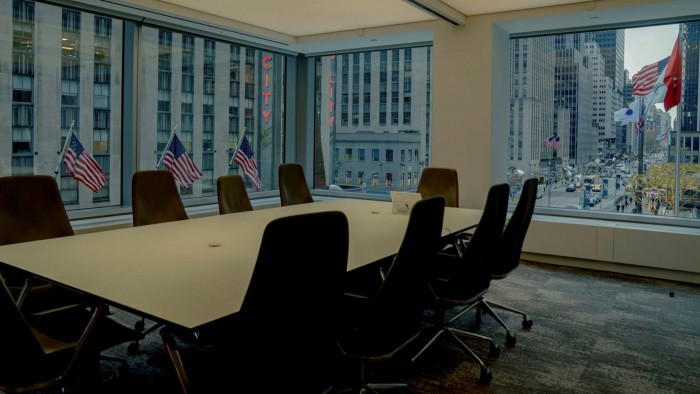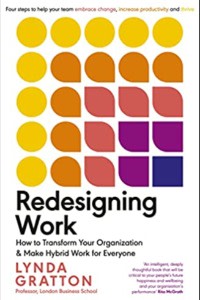Redesigning Work — what next for the office?

Roula Khalaf, Editor of the FT, selects her favourite stories in this weekly newsletter.
It’s always interesting when the future catches up with past predictions. Four years ago we at PwC brought together 4,000 of our people for an event titled Tomorrow Today. Designed to give attendees a taste of the future of work, it gave many their first experience of a VR headset and online meetings. Little did we know that two years later, speaking to a screen of human tiles would become the norm, with the 9-5 day banished forever.
The pandemic undoubtedly precipitated the most profound shift in office work for generations. The big question now is what comes next.
Lynda Gratton, professor of management practice at London Business School, believes that businesses are facing an extraordinary opportunity for change. In Redesigning Work (which is published in the US in May) she argues that this transformation should be motivated by the technological, demographic and social needs that are shaping how, where and why we work — together with our learnings from the pandemic.
Much has been written about the shifts in work over the last two years, but Gratton draws on research to offer a fresh perspective on what this will mean. She explains that in normal circumstances organisations are in a state of “freeze” — referencing a concept developed by the psychologist Kurt Lewin — their culture, structure and practices are fairly fixed. Usually a company will “unfreeze” in its own time and its own way in response to an external threat. The pandemic led to a collective “unfreeze”, and widespread thinking on how to respond to issues such as wellbeing and connectivity.
How can organisations now capitalise on their more fluid state to create a better working model before they start to “refreeze”?
Despite the book’s subtitle, Gratton is not wedded to the hybrid approach. Instead the opportunity is to create a way of working that resonates with a company’s purpose and acknowledges the capabilities and motivations of their employees.
She cites Goldman Sachs as an organisation that has been vocal about its preference for its people to work in the office. Its target employees are likely to prioritise prestigious projects, and colleagues they can learn from, over flexibility. These factors should be at the heart of their organisation design, Gratton argues, from how work is distributed to office layouts. But she also underlines the importance of “fairness” in any work redesign, using two hypothetical employees — Amy, “a single person without caring responsibilities in a group where two of her co-workers have young children; and Eric “an assembly-line worker with office-based colleagues” — to model outcomes.
Gratton sets out a four step design-process covering understanding; reimagining; modelling and testing; and acting and creating. In my view the most crucial is the first — understanding what matters — grasping a sense of the skills, networks and jobs that are critical for productivity, how knowledge flows, what employees want from work, and how people experience work at different points in their life. Get this wrong and changing the workplace could do more harm than good.
Among the concerns about changing working patterns that Gratton identifies, two are particularly important: the impact on the ability of young people to learn, socialise and network; and the impact on the serendipitous encounters that happen when people bump into each other.
Gratton suggests businesses that lean more towards virtual working will need to invest in “knowledge-capturing” processes to prevent blocking these channels. Yet she admits that “frankly, we don’t know yet” if virtual interactions can replicate face-to-face encounters for sharing “the insights, know-how, mental models, ways of framing that are held in the minds of individuals and are part of how they see and interact with the world.”
Other future unknowns include the availability and changing preferences of workers. For example, an organisation that goes fully virtual may assume there will be sufficient job-seekers who prefer working from home, but what if they then need to fish from a bigger pond?
I see first hand how priorities can shift or be brought into sharper focus; the war in Ukraine, for example, is driving a huge desire from our people to connect and make a difference, such as in supporting refugees. While Gratton’s book predates the humanitarian crisis, she makes clear the importance of looking beyond the organisation, such as the role businesses play in communities. Likewise on how organisational change can impact sustainability (don’t assume virtual work is better).

Redesigning Work is very much a how-to guide, with practical frameworks and examples. The rigour and discipline Gratton brings to the book might surprise those who haven’t been involved in organisational change. The message is clear: don’t leave the future of work to chance.
But it is the human insight that resonated most. As Gratton says, it’s easy to redesign work by thinking too much about the tasks and without thinking about the important moments for people, such as joining a new team or winning work. You have to ask yourselves whether proposed changes will make these experiences worse or better. In my experience, a happy workforce is definitely a more productive one.
Redesigning Work: How to Transform Your Organisation and Make Hybrid Work for Everyone by Lynda Gratton Penguin Business, £14.99/The MIT Press $19.95, 256 Pages
Kevin Ellis is chairman and senior partner at PwC UK
Comments